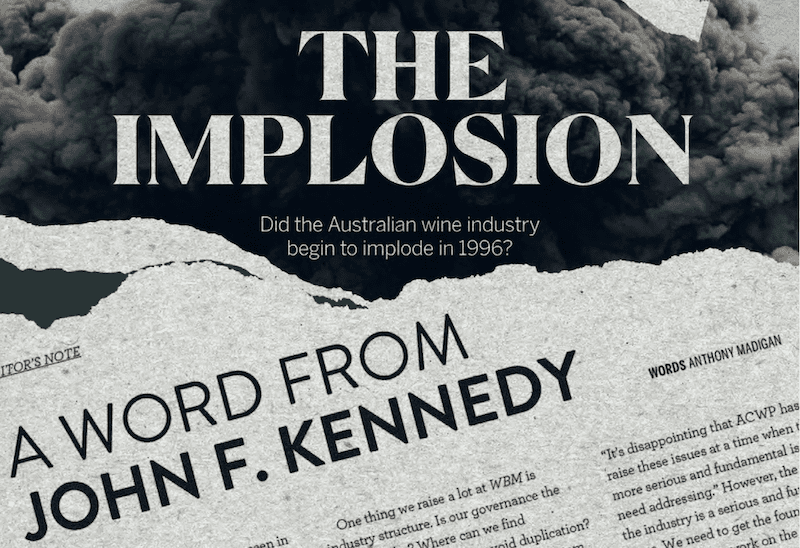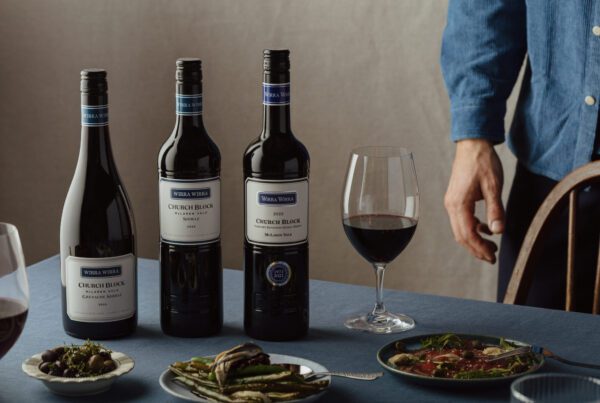
Alister Purbrick responds to articles published in the November-December 2023 issue of WBM – Australia’s Wine Business Magazine.
I take exception to two articles that were published in WBM in the November-December 2023 issue: ‘A Word from John F Kennedy’ by Anthony Madigan; and ‘The Implosion, Did the Australian Wine Industry Begin to Implode in 1996?’ by Richard Smart.
I applaud the article published in the same edition titled “The Future is Fine” by Brian Croser.
‘A Word from John F Kennedy’
The gist of this article is that the Australian wine industry currently has “no purpose, no direction – and certainly no leadership from industry bodies”.
I believe that our industry has been caught in a perfect storm of circumstances in the last three years which has almost landed a knockout punch.
Covid-19 hurt, the Russia/Ukraine War hurts, a high inflationary environment is really turning things upside down with supplier and labour costs dramatically increasing, and the effective closure of the China market was nearly terminal.
Add to the above challenges the fact that our now two biggest markets, the United Kingdom and America, are in decline and it’s obvious that Wine Brand Australia is not the hot brand that it was.
There is no instant fix, no silver bullet… and even if the China market opens as expected in April 2024, it will be 50 percent of the size that it was ($1.25 billion) and less red wine dominant, therefore, will not help much to balance industry’s excess bulk red wine stocks.
Anthony doesn’t mention that Wine Australia and Australian Grape & Wine have been canvassing our grapegrowers and winemakers across Australia to develop the One Grape & Wine Sector Plan which was released for further industry input in early January 2024.
“Where is the leadership,” Anthony asks.
It’s there in this Plan, which is very comprehensive and details a short, medium and long term path forward for our industry.
Of course, the high-level goals and aspirations outlined in the Plan are only the beginning, and now fully costed short, medium and long term action plans must be created which outline the strategies that will be employed to achieve each goal, who will be responsible for the implementation of each strategy and the timeline for each strategy to be achieved.
Obviously, we need to prioritise the development of the short term action plans to endeavour to kickstart our industry’s recovery from the current dire situation.
Make no mistake, if this Plan is implemented really well, it will lead to a sustainable and profitable industry, but it will need significant Federal and State Government funding because our industry simply does not have the financial wherewithal to fund it… and Wine Australia will have decreased levy collections from the 2025 vintage which will mean industry will have less funds to resolve the many challenges facing us.
To his credit, Anthony does make some valid points:
• “Is our governance the best it can be?”
• “Where can we find efficiencies?”
• “How can we avoid duplication?”
• “How can we add value?”
• “Is our levy system right for the times?”
All of these points are on Wine Australia and Australian Grape & Wine’s current agendas and are being addressed behind closed doors.
When decisions have been made and/or solutions found, they will be telegraphed widely to industry for feedback and input so that we end up with the best decisions leading to the best outcomes for our grapegrowers and winemakers.
What we do need in these most testing of times, is industry unity, focus and agreement on what decisions can move the dial in the short, medium and long term.
Australian Commercial Wine Producers (ACWP) is dividing our industry at a time when we’re all agreed on the key decisions that need to be made.
This organisation is sucking the oxygen out of our industry at a time when we need all the oxygen we can get.
I beseech Bill Moularadellis to put ACWP on hold and come back into the Australian Grape & Wine fold.
We can do with his wise counsel on all the matters that we’re actually in violent agreement on.
Anthony finishes his article with these words: “Maybe we’ve been looking for leadership in all the wrong places.”
I take enormous exception to that sentence.
I know of so many wine industry members who selflessly give of their time to sit on industry boards, committees and sub-committees.
All these individuals are committed to making our industry sustainable and successful… and they demonstrate true leadership all the time.
‘The Implosion – Did the Australian Wine Industry Begin to Implode in 1996?’
The gist of this article is that Strategy 2025, which was launched in June 1996, was flawed because it was implemented too successfully which ultimately led to the woes that our industry finds itself in today.
When I started in 1976 with Mildara Wines in Coonawarra, our industry was dominated by three winemakers – Penfolds, Lindeman’s and Orlando – who were ‘fondly’ known as the PLO, who controlled the decision making in the then Australian Wine & Brandy Producers Association (AWBPA), our peak national representative industry body in those days, because decisions were taken on a tonnes crushed basis and these three winemakers controlled over 50 percent of the national crush.
On top of that, our industry was very small, fragmented and disjointed… not much more than a cottage industry, really.
With the realisation that a truly national industry representative body needed to be formed to replace the AWBPA in the 1980s, if our industry was to move forward, the Winemakers Federation of Australia (WFA) was created in 1990.
High on WFA’s agenda was the creation of an agreed whole-of-industry growth plan, which ultimately led to the creation of Strategy 2025, which was endorsed by the entire industry at the time.
The thrust of Richard’s article is that this flawed industry plan was implemented too successfully, ergo, the industry’s pain currently.
I would pose this question, which Anthony’s article verbalises – if industry had shown no leadership, had not created a plan and had stayed the cottage industry that it was, would this be a preferred outcome compared to what our industry has grown to currently, even with the current challenges we’re all dealing with?
I for one, have enjoyed the ride and much prefer to be dealing with our industry’s current challenges than still being stuck in the 1980s – then an industry with no critical mass, no leadership and no future.
What individual companies do with an industry plan is up to them.
The plan simply provides the opportunity.
Individual winemakers have to manage risk and make decisions accordingly.
Anthony is bemoaning the fact that there is a lack of leadership in our industry today.
Richard is bemoaning the fact that leadership and the creation of a dynamic whole of industry plan, which was too successfully implemented from 1996, has led to our industry’s woes today.
Come on, we can’t have it both ways.
What we need right now is a dynamic whole-of-industry plan which can slowly but surely lead our industry out of our current darkness into light.
I would like to think that the new One Grape & Wine Sector Plan can be that vehicle.
It needs to be appropriately funded but if that funding can’t be secured, then we have the ultimate dilemma – a very good plan that can’t be successfully implemented due to a lack of resource.
‘The Future is Fine’
Following on from my comments above, I would like to congratulate Brian Croser on this thoughtful article.
He’s captured the future direction which our industry must embrace if we are to ultimately be a sustainable and profitable industry.
It’s not to say that inland-grown grapes and wine don’t have a place in what our future industry should look like, but it does mean that these winemakers’ wines should not be leading the charge.
The harsh reality is that many of our international competitors, such as Chile, Argentina, South Africa and some European countries, have a much lower cost of production and arguably make as good, if not better, warm area sourced wines – we simply can’t compete.
We have to play to our strengths, agree on what we do well and what can differentiate Australian wine from our international peer competitors.
A future sustainable and profitable industry is the main game, otherwise, what’s the point?
I urge everyone to read/reread Brian’s article as it is a very salient sign post to the future that our industry should aspire to.
Alister Purbrick is a board member of Australian Grape & Wine and a director of Tahbilk Group.
• This article was first published in WBM – Australia’s Wine Business Magazine. To subscribe to Australia’s #1 wine industry publication click here.













Recent Comments